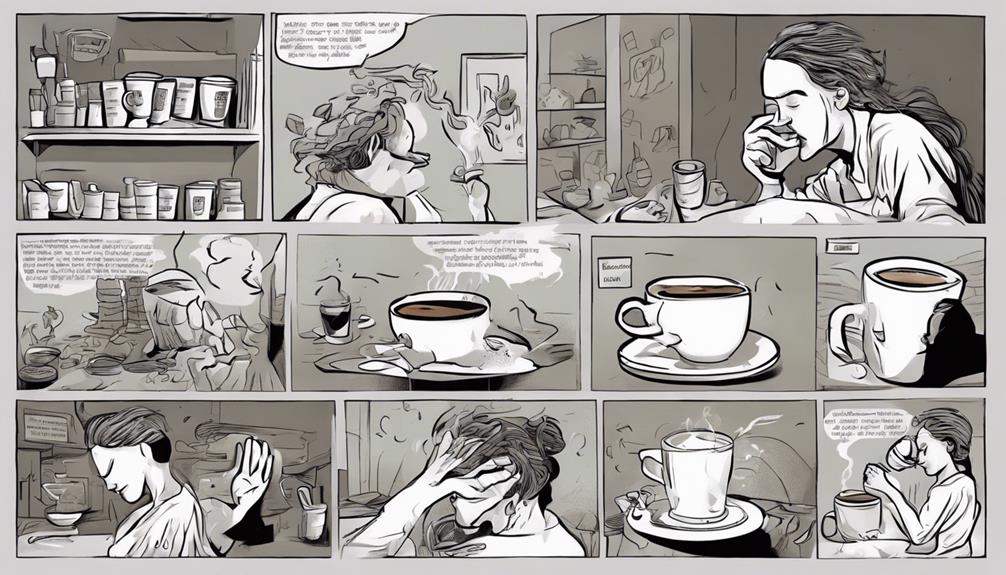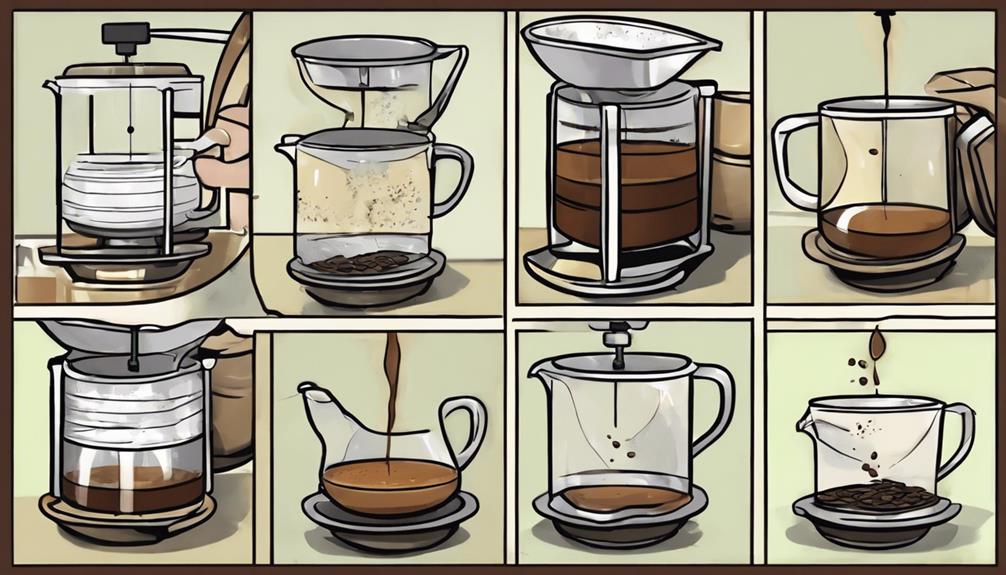To reduce your heart rate after consuming coffee, begin by staying hydrated with water. Take deep breaths to calm down and regulate your heart rate. Engage in light physical activity such as walking. If your heart rate remains high, seek advice from a healthcare professional. The caffeine in coffee affects your heart by triggering the release of epinephrine, which leads to an increased heart rate and irregular rhythms. Learn ways to manage heart palpitations caused by caffeine consumption. Understand how factors like stress and hydration can influence your heart rate. Consider the potential long-term effects of caffeine on your heart’s functioning. Use techniques like deep breathing, physical movement, and proper hydration to lower your heart rate after having coffee. Additionally, mindfulness practices and stress-reducing techniques can help in regulating your heart rate. Making regular exercise a part of your routine can also enhance your overall heart health. For more tips on managing your heart rate, you can explore some fresh breath tips to relax your body and mind. Remember to pay attention to your body and consult a healthcare professional if you experience persistent irregularities in heart rate. Taking proactive measures to lower your heart rate can have a positive impact on your overall well-being.
Key Takeaways
- Hydrate with water to counteract caffeine's dehydrating effects.
- Practice deep breathing techniques for relaxation and heart rate regulation.
- Engage in short physical activity like walking to lower heart rate.
- Consult a healthcare professional for persistent rapid heart rate symptoms.
- Monitor resting heart rate and consider long-term effects of caffeine on heart health.
Hydrate to Counteract Caffeine Effects
Wondering how to bring your heart rate down after that cup of coffee? Start by hydrating to counteract the effects of caffeine on your body. Drinking water helps combat the dehydrating impact of caffeine, which can contribute to an elevated heart rate. By increasing your water intake, you can support your cardiovascular health and aid in regulating your heart rate more effectively.
Hydration plays an essential role in reducing the stimulating effects of caffeine on your heart. Replenishing your fluids after consuming coffee can assist in bringing your heart rate back to a more favorable level. Water not only helps in rehydrating your body but also promotes overall cardiovascular well-being.
To keep your heart rate in check after coffee, prioritize staying well-hydrated throughout the day. By making conscious efforts to hydrate adequately, you can support your heart health and minimize the impact of caffeine on your body's physiological responses.
Deep Breathing Techniques for Relaxation
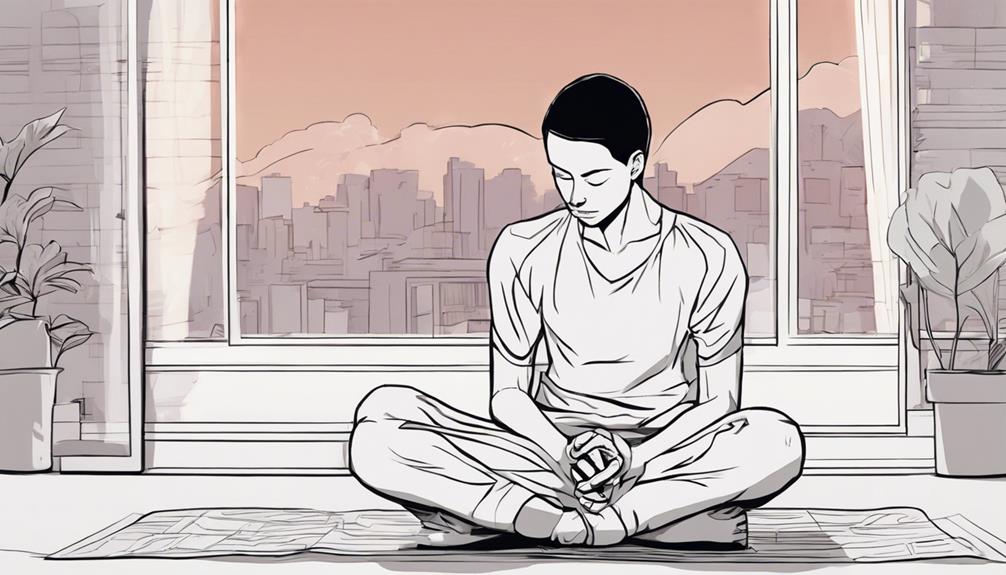
Take a moment to focus on your breath – inhale slowly through your nose, then exhale gently through your mouth.
Deep breathing can trigger a relaxation response in your body, easing stress and tension.
Breathing for Relaxation
Engage in deep breathing techniques to effectively bring your heart rate down and promote relaxation after consuming coffee. Deep breathing involves taking slow, deep breaths to activate the body's relaxation response, helping to lower heart rate and reduce stress.
By stimulating the vagus nerve, deep breathing aids in heart rate regulation, counteracting the heart rate-increasing effects of caffeine. Consistent practice of deep breathing exercises can improve heart rate variability, benefiting overall heart health.
When you feel the effects of caffeine causing your heart rate to rise, take a moment to focus on your breath. Inhale deeply through your nose, allowing your abdomen to expand, then exhale slowly through your mouth. Repeat this process several times, feeling the tension release from your body and your heart rate gradually slowing down.
Incorporating deep breathing into your routine can be a powerful tool in managing the effects of coffee consumption on your heart rate and promoting relaxation.
Deep Breath Benefits
Deep breathing techniques offer numerous benefits for relaxation and stress reduction, making them a valuable tool for managing daily tension. By engaging in deep breathing exercises, you can activate your parasympathetic nervous system, which helps promote a sense of calm and reduce stress levels.
Taking slow, deep breaths can effectively lower your heart rate and blood pressure, contributing to a more relaxed state of being. This process aids in regulating your heart rate and improving overall cardiovascular function by increasing oxygen supply to your body.
Regular practice of deep breathing not only enhances lung function but also boosts mindfulness and alleviates feelings of anxiety. Incorporating deep breathing exercises into your daily routine can serve as a simple yet powerful method to bring down your heart rate, especially after consuming caffeine.
Embrace the benefits of deep breathing for relaxation and stress reduction, and witness the positive impact on your well-being.
Benefits of Short Physical Activity
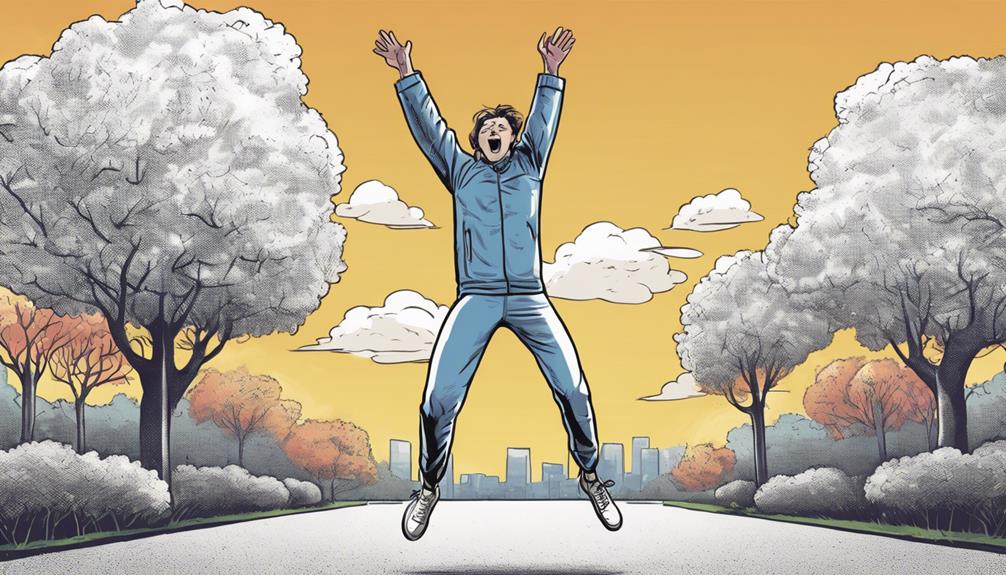
By incorporating short bursts of physical activity into your routine, you can experience significant benefits for your heart rate regulation. Engaging in activities such as walking for just 10-15 minutes can efficiently decrease your heart rate, especially after consuming caffeine.
Walking is a simple yet effective way to regulate your heart rate without experiencing side effects like dizziness or lightheadedness.
Physical movement plays an essential role in promoting blood circulation throughout your body, which in turn aids in the natural regulation of your heart rate. By incorporating short bouts of physical activity into your post-caffeine routine, you can effectively bring down your heart rate levels.
This practical approach not only helps in managing your heart rate but also provides overall health benefits. Next time you feel the need to lower your heart rate after that cup of coffee, consider taking a short walk to reap these advantages.
Consulting Healthcare Professional for Symptoms
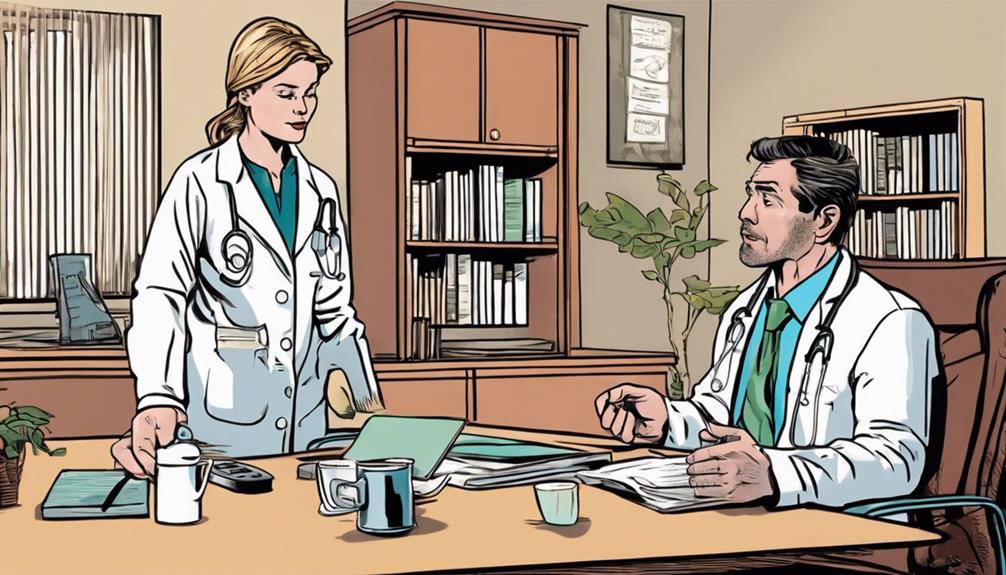
If you notice persistent rapid heart rate or palpitations post-coffee, seeking medical advice is important. Consulting a healthcare professional can help evaluate symptoms and guarantee proper assessment of your heart rate. Additionally, it is essential to consider making healthier lifestyle choices, such as reducing caffeine intake and incorporating regular exercise, to help manage and control heart rate. Maintaining a balanced diet and managing stress levels can also contribute to overall heart health. Making these changes can significantly improve heart rate and overall well-being.
Don't hesitate to reach out for expert guidance on managing any concerns related to your heart health.
Symptom Evaluation Importance
To properly address any concerning symptoms post-coffee, consulting a healthcare professional is vital. Symptoms like a racing heartbeat after consuming coffee may indicate underlying issues that require thorough evaluation.
Particularly in relation to heart health, cardiac symptoms following coffee consumption shouldn't be ignored. Seeking medical attention promptly is important for a proper diagnosis and tailored treatment plan.
Premier Cardiology Consultants specialize in providing diagnostic and clinical care for individuals experiencing cardiac symptoms post-coffee. Regular cardiac screenings may be recommended to monitor and address any potential concerns.
If you're experiencing persistent or severe symptoms after consuming coffee, don't hesitate to reach out to Premier Cardiology Consultants at 516-437-5600. Taking proactive steps in symptom evaluation and seeking appropriate medical guidance can greatly impact your heart health and overall well-being.
Healthcare Provider Consultation
When experiencing symptoms like a rapid heart rate post-coffee, seeking guidance from a healthcare provider is vital for proper evaluation and personalized care. Consulting a healthcare professional is essential in understanding individual health conditions and receiving tailored recommendations to manage heightened heart rate after consuming coffee.
It's important to address concerns about heart rate elevation to determine whether it's a normal reaction to caffeine or signifies an underlying health issue that requires attention. Healthcare providers can offer valuable insights into lifestyle adjustments, potential medication changes, or further cardiac assessments if persistent heart rate issues arise.
Rapid Heart Rate Assessment
Seeking advice from a healthcare professional promptly can provide crucial insights into assessing and managing fast heart rate symptoms after coffee intake. If you encounter persistent fast heart rate, particularly accompanied by symptoms like fluttering heartbeats, chest discomfort, or lightheadedness after drinking coffee, seeking medical assessment is vital. Medical experts are prepared to evaluate heart rate irregularities following coffee consumption, pinpoint any root causes contributing to the fast heart rate, and suggest suitable treatment. It is worth mentioning that severe or alarming symptoms linked to fast heart rate should trigger immediate medical attention to guarantee timely intervention and prevention of potential complications.
To highlight the importance of seeking medical assessment for fast heart rate after coffee consumption, consider the following table: As shown in the table, a fast heart rate after coffee consumption can be a sign of an underlying medical condition such as arrhythmia or anxiety. It is crucial to seek medical assessment if you frequently experience rapid heartbeat after consuming coffee, as it could indicate a potentially serious health issue that needs to be addressed.
In addition to seeking medical assessment, individuals can also consider implementing “morning coffee breath tips” such as practicing good oral hygiene, staying hydrated, and using breath fresheners to minimize any potential negative effects of coffee on their heart rate and overall health.
| Significance of Medical Assessment for Fast Heart Rate |
|---|
| Early identification of heart rate irregularities post-coffee |
| Detection of underlying factors leading to fast heart rate |
| Suggestions for proper treatment and care |
Understanding Caffeine's Impact on Heart
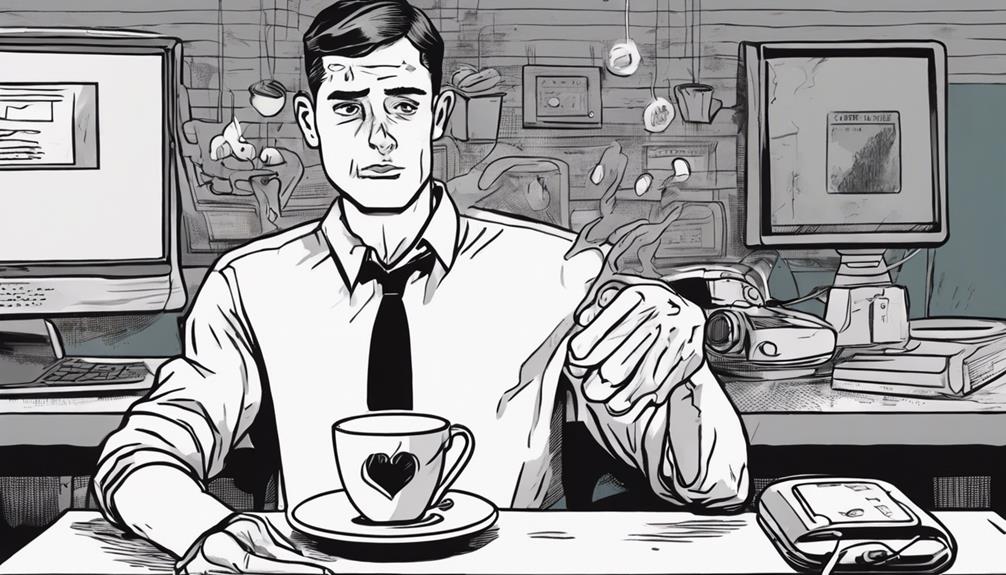
Caffeine's influence on the heart is vital, primarily through its impact on epinephrine levels. When you consume caffeine, it can lead to increased heart rate and forceful heartbeats due to the surge in epinephrine, which is also known as adrenaline.
For some individuals, especially those sensitive to caffeine, this can result in abnormal heart rhythms, causing palpitations or a racing heartbeat. These symptoms are common after caffeine intake and may take time to subside as the body metabolizes the caffeine.
If you experience persistent rapid heartbeats even after the caffeine has worn off, it's advisable to seek regular cardiac screenings to monitor your heart health. Monitoring your heart's response to caffeine intake is essential in understanding how it affects your cardiovascular system and taking necessary precautions to maintain a healthy heart rhythm.
Managing Heart Palpitations From Caffeine
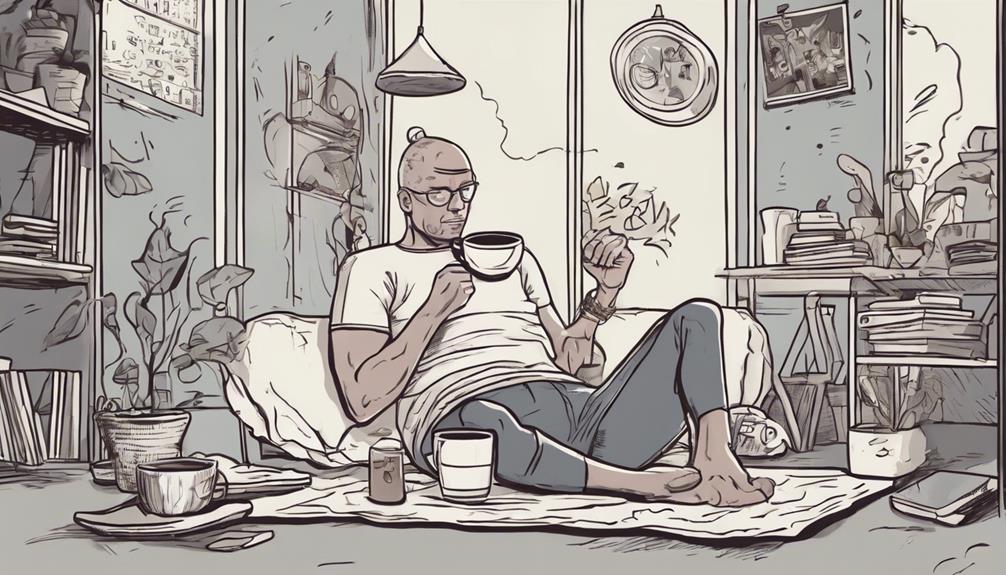
If you experience heart palpitations from caffeine, there are ways to manage them effectively.
Strategies may include reducing caffeine intake, practicing relaxation techniques for immediate heart rate reduction, and monitoring your heart rate regularly.
Understanding the long-term effects of caffeine on your heart health is also essential for managing palpitations.
Palpitation Management Strategies
To manage heart palpitations caused by caffeine, consider incorporating relaxation techniques like deep breathing. Deep breathing promotes relaxation, assisting in reducing stress levels and calming your heart rate.
In addition to relaxation methods, engaging in gentle physical activity like walking can help lower your heart rate post-caffeine intake. Hydrating with water is also beneficial, as it can aid in flushing out excess caffeine from your system, potentially decreasing heart palpitations.
It's crucial to refrain from additional stimulants and establish a peaceful environment to support the management of caffeine-induced heart palpitations. Monitoring your heart rate fluctuations is vital, and if palpitations persist after consuming caffeine, seeking medical advice is necessary for your heart health.
Immediate Heart Rate Reduction
In managing heart palpitations from caffeine, focus on immediate heart rate reduction techniques such as deep breathing and light exercise to counteract the stimulant effects effectively.
Deep breathing exercises can help lower your heart rate by promoting relaxation and reducing stress. Additionally, taking a short walk after consuming caffeine can aid in decreasing your heart rate without causing additional side effects.
Remember to stay hydrated by drinking water, as this can also assist in reducing your heart rate and support overall cardiovascular function. By incorporating these simple strategies into your routine, you can effectively manage heart palpitations caused by caffeine consumption.
Immediate heart rate reduction methods like deep breathing and light exercise are practical ways to regulate your heart rate and counteract the stimulating effects of caffeine on your body. Make these techniques a part of your post-caffeine routine to promote a healthier heart rate and overall well-being.
Long-Term Caffeine Effects
Managing heart palpitations from caffeine in the long term requires a proactive approach to monitoring your caffeine intake and its impact on your heart health.
Regular caffeine consumption can potentially lead to heart palpitations, indicating underlying heart issues that necessitate medical attention. It's essential to regularly evaluate your heart health if caffeine consumption consistently triggers palpitations.
Understanding how caffeine affects heart rhythms is vital in managing and addressing related symptoms effectively. Consulting a healthcare provider for guidance on your caffeine intake and its impact on heart health can help prevent potential complications.
Long-Term Effects of Caffeine Consumption
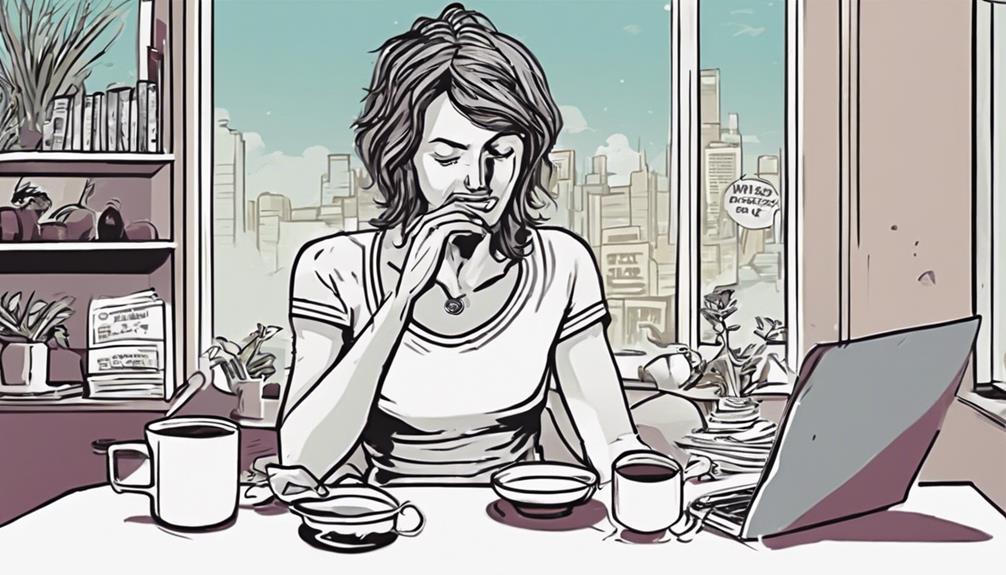
With consistent caffeine intake, your body gradually develops tolerance, diminishing its impact on your heart rate over time.
Long-term caffeine consumption can lead to adaptation within your system, causing a reduction in the stimulant effects on your heart rate. As you continue to consume caffeine regularly, your body adjusts to its presence, potentially resulting in a less pronounced increase in heart rate compared to when you first started consuming caffeine.
Over time, individuals may experience varying responses to caffeine, with some showing a decreased sensitivity to its effects on heart rate. This long-term adaptation to caffeine highlights the importance of individual differences in how our bodies react to this stimulant.
It's crucial to be aware of these potential changes in your body's response to caffeine as you continue to consume it over an extended period, as they can impact your heart rate regulation.
Lifestyle Factors Affecting Heart Rate
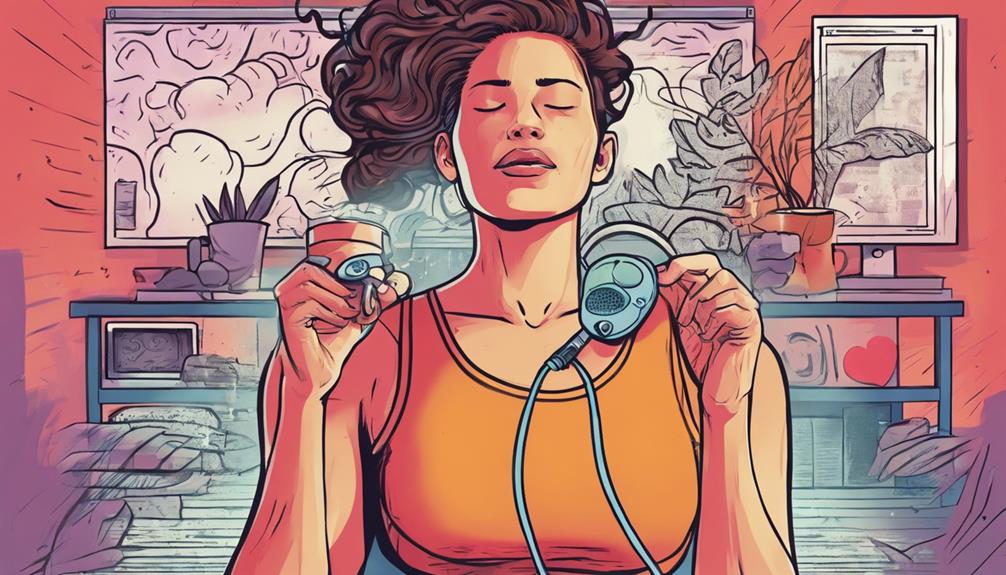
Various lifestyle factors can greatly impact your heart rate, including stress, physical activity, medication usage, age, and hormonal changes.
Stress and anxiety can elevate heart rates, while regular exercise such as yoga and endurance training can help lower resting heart rate over time.
Dehydration can increase the heart's workload, emphasizing the importance of staying properly hydrated to reduce resting heart rate.
Stimulants like caffeine can lead to dehydration, impacting heart rate and potentially raising it.
Additionally, certain medications, age, and hormonal changes can all play a role in affecting heart rates. It's essential to monitor these factors and make adjustments where necessary to maintain a healthy heart rate.
Remember that alcohol consumption can also increase heart rate, so moderation is key for overall heart health.
Nutrition's Role in Heart Rate Management

To enhance your heart rate, consider the impact of nutrition on heart rate management. Particularly, focus on the role of omega-3 fatty acids found in fish and a diet rich in polyphenols, vitamins, dietary fiber, and vitamin C.
Omega-3 fatty acids, abundant in fish, have been linked to lower heart rates and improved cardiovascular health. Including these healthy fats in your diet can help regulate your heart rate. Additionally, a diet packed with polyphenols, vitamins, fiber, and vitamin C promotes heart health, aiding in the management of heart rate fluctuations.
Balancing your intake of these nutrients through a diverse and nutrient-rich diet can positively impact your heart rate and overall cardiovascular well-being. By incorporating foods rich in omega-3 fatty acids and other heart-healthy nutrients, you support the best heart function.
Monitoring Resting Heart Rate for Health
Monitoring your resting heart rate is essential for gaining valuable insights into your cardiovascular health. Your resting heart rate, the number of times your heart beats per minute while at rest, can provide vital information about your heart's efficiency and overall well-being.
Here are key points to keep in mind when monitoring your resting heart rate:
- Detection of Abnormalities: Regularly monitoring your resting heart rate can help in identifying any irregularities or changes in your heart function, allowing for timely intervention and management.
- Guiding Lifestyle Modifications: Understanding your resting heart rate can help you make necessary lifestyle adjustments. Lower resting heart rates are often linked with better cardiovascular fitness, indicating the effectiveness of your lifestyle choices.
- Assessing Health Interventions: Tracking changes in your resting heart rate over time enables you to assess the impact of health interventions, such as exercise routines and stress management techniques, on your cardiovascular health. By consistently monitoring your resting heart rate, you can take proactive steps towards maintaining a healthy heart.
Frequently Asked Questions
How to Calm Heart Rate After Caffeine?
To calm your heart rate after caffeine, try walking for 10-15 minutes, practice deep breathing exercises like diaphragmatic breathing, and drink water. These actions help reduce heart rate by promoting relaxation and hydration.
Why Is My Heart Rate so High After Coffee?
Your heart rate is elevated after coffee due to caffeine's stimulation of adrenaline release. This common response to caffeine temporarily increases heart rate. If sensitive to caffeine, you may experience a more pronounced rise.
How to Flush Out Caffeine Fast?
To flush out caffeine fast, chug water like a champ, take a brisk walk, breathe deeply, snack on potassium-rich goodies, and kick back for some chill time. Your body will thank you by bringing that heart rate down!
How Do You Treat Caffeine Induced Tachycardia?
To address caffeine-induced tachycardia, try deep breathing exercises, walking for a few minutes, or drinking water. Deep breathing has been shown to be particularly effective in reducing heart rate post-caffeine consumption. Stay hydrated for best results.
Conclusion
As you navigate the ups and downs of caffeine on your heart rate, remember to listen to your body's whispers before they turn into shouts.
Like a captain steering a ship through stormy seas, take control of your health by hydrating, breathing deeply, and moving your body.
Seek guidance from a healthcare professional if needed, and sail towards a calmer, healthier heart rate.
Smooth waters await on the horizon.


